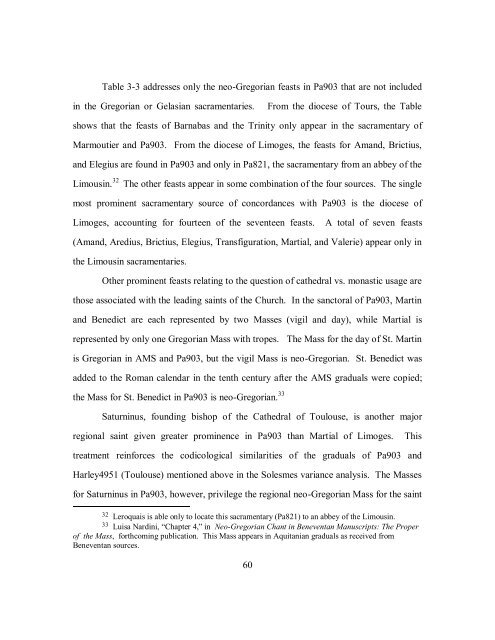Front Matter Template - The University of Texas at Austin
Front Matter Template - The University of Texas at Austin
Front Matter Template - The University of Texas at Austin
Create successful ePaper yourself
Turn your PDF publications into a flip-book with our unique Google optimized e-Paper software.
Table 3-3 addresses only the neo-Gregorian feasts in Pa903 th<strong>at</strong> are not included<br />
in the Gregorian or Gelasian sacramentaries. From the diocese <strong>of</strong> Tours, the Table<br />
shows th<strong>at</strong> the feasts <strong>of</strong> Barnabas and the Trinity only appear in the sacramentary <strong>of</strong><br />
Marmoutier and Pa903. From the diocese <strong>of</strong> Limoges, the feasts for Amand, Brictius,<br />
and Elegius are found in Pa903 and only in Pa821, the sacramentary from an abbey <strong>of</strong> the<br />
Limousin. 32 <strong>The</strong> other feasts appear in some combin<strong>at</strong>ion <strong>of</strong> the four sources. <strong>The</strong> single<br />
most prominent sacramentary source <strong>of</strong> concordances with Pa903 is the diocese <strong>of</strong><br />
Limoges, accounting for fourteen <strong>of</strong> the seventeen feasts. A total <strong>of</strong> seven feasts<br />
(Amand, Aredius, Brictius, Elegius, Transfigur<strong>at</strong>ion, Martial, and Valerie) appear only in<br />
the Limousin sacramentaries.<br />
Other prominent feasts rel<strong>at</strong>ing to the question <strong>of</strong> c<strong>at</strong>hedral vs. monastic usage are<br />
those associ<strong>at</strong>ed with the leading saints <strong>of</strong> the Church. In the sanctoral <strong>of</strong> Pa903, Martin<br />
and Benedict are each represented by two Masses (vigil and day), while Martial is<br />
represented by only one Gregorian Mass with tropes. <strong>The</strong> Mass for the day <strong>of</strong> St. Martin<br />
is Gregorian in AMS and Pa903, but the vigil Mass is neo-Gregorian. St. Benedict was<br />
added to the Roman calendar in the tenth century after the AMS graduals were copied;<br />
the Mass for St. Benedict in Pa903 is neo-Gregorian. 33<br />
S<strong>at</strong>urninus, founding bishop <strong>of</strong> the C<strong>at</strong>hedral <strong>of</strong> Toulouse, is another major<br />
regional saint given gre<strong>at</strong>er prominence in Pa903 than Martial <strong>of</strong> Limoges. This<br />
tre<strong>at</strong>ment reinforces the codicological similarities <strong>of</strong> the graduals <strong>of</strong> Pa903 and<br />
Harley4951 (Toulouse) mentioned above in the Solesmes variance analysis. <strong>The</strong> Masses<br />
for S<strong>at</strong>urninus in Pa903, however, privilege the regional neo-Gregorian Mass for the saint<br />
32 Leroquais is able only to loc<strong>at</strong>e this sacramentary (Pa821) to an abbey <strong>of</strong> the Limousin.<br />
33 Luisa Nardini, “Chapter 4,” in Neo-Gregorian Chant in Beneventan Manuscripts: <strong>The</strong> Proper<br />
<strong>of</strong> the Mass, forthcoming public<strong>at</strong>ion. This Mass appears in Aquitanian graduals as received from<br />
Beneventan sources.<br />
60

















